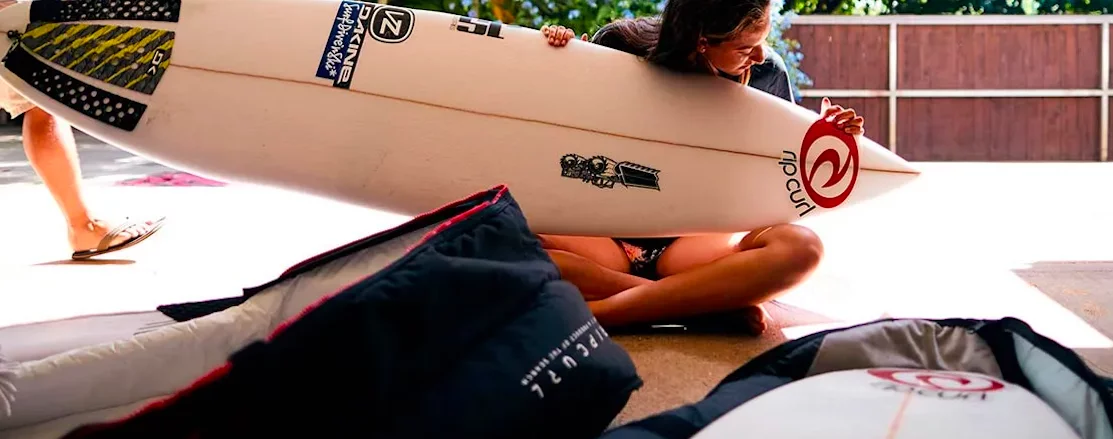
07 Dec How to guide: Packing your board for travelling
Surf holidays are the best type of holiday – there’s no question about it. But packing for a surf trip can add an extra level of anxiety when you’re unsure how to pack your beloved board properly. There’s nothing worse than arriving at your destination with pumping surf and your board is in two pieces or has a huge chunk out of the rail!
Why travel with your own board?
Picture this, you arrive after a long sweaty journey, hot off your transfer, you feel that offshore breeze on your face and all ll you want to do is hop straight into that ocean! However, you don’t have your board and the local hire place is closed for the day! Looks like you’ll have to settle for a swim…
Also, keep in mind that not every location will have good hardboards or a big variety to choose from. In some destinations, these boards can be unwanted or secondhand, often used daily and not kept in the best condition and it can sometimes work out more expensive than taking your own. But maybe taking your board isn’t an option or you don’t even have one? In this case, we definitely recommend pre-booking a board to minimise the risk!
But honestly, if you wish to travel with your own board – it’s easy! We’ve got your back – keep reading for our top tips on how to do it properly.

First things first – check your airline fees, regulations and restrictions
Some airlines are a surfer’s dream while others may appear cheap at first, but will have a big sting when you try to add a board! This is why it’s super important to check the luggage allowance and T&Cs.
Some airlines allow you to take your board for free!! They have no dimension restrictions or allow up to 9ft in length on your hold luggage. This means, as long as your packed board bag weighs under their allowance (usually 30kg), you can take it as your standard-hold luggage and you’re good to go. Hello, friends of surfers!
Other airlines have fair sporting goods add-ons for boards up to 8ft (on average around £100). But you should always check this as some companies put a 6ft cap on bags, so unless you’re a shortboarder, you’re going to have to upgrade your add-on.
A few companies are not kind to surfers at all and have HUGE surfboard fees. If this is the case, it’s best to look to other airlines and if you have no other option, rent a board at your destination.
Top tip: make sure your packed board bag weighs under the airline’s allowance before you get to the airport, or you could be met with a BIG charge or you’ll be throwing out (or putting on) all your clothes to reduce the weight – it’s happened to the best of us!
Airlines who are reasonable: United Airlines, Emirates, American Airlines, Air Asia, British Airways, Qantas, Malaysian airlines and Ryan Air (yes really!)
Please note, airline policies are always changing. It’s best to call your airline and clarify directly or ask your travel agent who booked the flights for you.

Now let’s get a bag
This will vary depending on how big your board is and how many you want to take but it’s important to always choose a high-quality, heavy-duty surfboard bag. Firstly, your board bag should be a little bigger than your biggest board to allow for extra padding at the nose and tail, but not too much extra room for your board to move around in transit. Other things to take into consideration are that your bag has straps to allow you to compress or expand it, plus a good carry strap. A bonus that we love, but isn’t always necessary, are coffin bags with wheels. This is great if you have a longboard or multiple boards for long walks through the airport, but it will add quite a bit of extra weight.
Our faves:
- FCS double board bag (very well priced and perfect for 1 board and clothes or 2 boards)
- FCS double board bag with wheels (the ultimate longboard bag)
- FCS triple board bag with wheels (if you can’t decide which of your boards to take, take them all!)
- Djarv quadruple coffin bag with wheels (a more upmarket option but super lightweight and compresses to 30% of its size!)

Woo, it’s time to pack…
1. First; remove the fins, leash and wax
You want to avoid any extra pressure on the tail of your board or even your fins snapping off! If you have glass-on fins, use a piece of polystyrene as a cover.
Don’t forget to pack your fin key for the other end!!
Also, it might seem like an extra hassle to remove your wax, but it’ll be worse if it melts all over your bag! Plus, there’s a good chance you’re heading somewhere warmer or colder than your local so it’s best to start fresh at the other end.

2. Use a board sock
This is an easy, lightweight extra layer to avoid scratches and is also useful when you reach your destination if you have to travel to the waves.

3. PROTECT THE RAILS, TAIL AND NOSE
You have a few options, you can either use foam pipe insulation, bubble wrap and duct tape it to your board OR our preferred option (and the better option especially if you have big rails on your board), Hexi-flex. An eco-friendly, easy, affordable board-saving invention – we LOVE it and so does the planet!

4. ONCE YOUR BOARD IS READY, FILL IN THE GAPS
Use towels and clothes as an extra layer of protection in your board bag (plus this means you won’t need an extra bag, win-win!). If you’re taking multiple boards, put a towel or extra padding in between the boards too. But avoid putting hard items in there unless they are well wrapped!

5. Add “Handle With Care,” “Top Load,” “Surfboard Inside,” and/or “Fragile” stickers on the outside of the bag
Luggage handlers aren’t the most delicate, so it’s best to give them a reminder!

Bonus tip:
Your board should be well protected if you follow all these steps but make sure to check your board before you leave the airport as it can be harder to make a claim once you’ve left and prove it was damaged in transit.
Now the only thing left to do is have an epic surf trip!!
Or if you’re reading this but haven’t booked your next surf adventure, check out our International Surf Camps!



No Comments